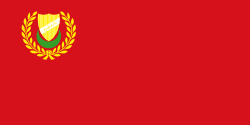Flag
 | |
| Use | Civil and state flag |
|---|---|
| Proportion | 1:2 |
| Adopted | 1912 |
| Design | A red field with the state's coat of arms on its upper hoist. |
Design
The Kedahan flag is essentially a red flag with only the state arms of Kedah charged on its upper hoist, the upper left quarter of the flag. The red, Kedah's traditional colour, signifies prosperity, [1] [2] while the flag's arms is as interpreted with the standalone arms.
History
During the beginning of the 18th century, Kedah's flag only consists of a plain red field. In 1821, the flag was changed to be charged with a yellow tiger. This flag came to be known as the "harimau terkam" (pouncing tiger) or "harimau melompat" (jumping tiger) flag. The flag was used during Sultan Ahmad Tajuddin Halim Shah II's reign, and was raised on top of the Kota Kedah before the Siam capture of the fort and occupation of the sultanate during which they took down the flag. The flag went on being used by the Sultan's troops while recapturing the land and remained as the state flag until 1912 when it was changed to instead be charged with the state arms on the upper hoist.


 The flag of Kedah used from the 18th century to 1821. Flag ratio: 1:2
The flag of Kedah used from the 18th century to 1821. Flag ratio: 1:2

 The flag of Kedah used from 1821 to 1912. Flag ratio: 1:2
The flag of Kedah used from 1821 to 1912. Flag ratio: 1:2Variants
Standards
Kedah's royalty flies a series of royal standards that consist of plain coloured flags with the state arms charged at the centre or flags with a canton of a different colour containing the state arms. [1] In addition, similarly designed Standards are also flown by high-ranking governments officials affiliated with the Sultan of Kedah. [1] Like the state flag, all Standards utilise any two of or all three colours: Red, green and yellow; the colours of the arms also vary between Standards.
The standards include: [1]
- Standard of the sultan : A yellow flag with the state arms charged at the centre. The wreath and shield of the arms are green, while the crescent is red.
- Standard of the sultanah: A yellow flag with a red canton containing the state arms. Similar to the original arms, the wreath and shield of the Standard's arms are yellow, while the crescent is green.
- Standard of the crown prince: A red flag with a yellow canton containing an entirely green state arms.
- Standard of the bendahara (prime minister): A red flag with a green canton containing an entirely yellow state arms.
- Standard of the president of the State Council and Sultan Advisor: A green flag with the state arms charged at the centre. The arms is entirely yellow.
Flags of Kedah
Maritime flags
As a formerly independent state, Kedah was known to fly ensigns on its ships. Among them were the state ensign and merchant ensign, the former similar in design as a variant of the Kedahan Standards, while the latter adopted a different design.
The state ensign took the appearance of a Standard-like design that simply incorporates a canton containing the state arms. The flag is blue, but unlike Standards of the design, its canton is essentially design as per the state flag, coloured red and containing the state arms in its original colours. [1]
The merchant ensign is of a completely different design, but incorporates all three of the state's flag colours in the form of three diagonally cut sections: A large, red, diagonal per bend stripe divides the upper fly—coloured yellow—and the lower hoist—coloured green. [1]
- State ensign
- Merchant ensign



